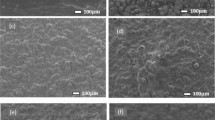Abstract
This study describes the effect of the presence of cobalt-chromium-molybdenum (CoCrMo) and titanium-6aluminium-4vanadium (Ti6AL4V) disc samples on the CD3-mediated in vitro response of human peripheral blood T lymphocyt es. Lymphocyte proliferation in the presence and absence of these metal alloy discs was measured by [3H]thymidine incorporation. Inhibition of lymphocyte proliferation was observed in the presence of CoCrMo disc samples. In contrast, the presence of the Ti6AL4V metal alloy discs had no effect on T cell proliferation. Ultrastructural studies using scanning electron microscopy revealed that the differences in the number of blast cells on uncoated CoCrMo and Ti6AL4V discs from a 4 day culture were consistent with the results observed in the proliferation experiments, i.e. fewer blast cells were seen on the CoCrMo than on the Ti6AL4V discs. In addition, a quantitative analysis of trace elements using total reflection X-ray fluorescence spectrometry in supernatants from 68 h in vitro cultures containing Ti6AL4V or CoCrMo disc samples was performed, revealing differences in the relative metal concentrations in the culture conditions tested. These differences point to the presence of cobalt in the supernatants as a possible determining factor of the inhibition observed. Because cell viability did not appear to change, a more complex mechanism involving the interaction of metals with T lymphocytes may account for the results obtained.
Similar content being viewed by others
References
Arosa FA, de Sousa M. 1995 Iron differentially modulates the CD-4lck and CD8-lck complexes in resting peripheral blood T-lymphocytes. Cell Immunol 161, 138–142.
Bravo I, Carvalho GS, Barbosa M, de Sousa M, 1990 Differential effects of eight metal ions on Lymphocyte differentiation antigens in vitro. J Biomed Mater Res 24, 160–168.
Bryan C, Nishiya K, Pollack M, Dupont B, de Sousa M. 1981 Differential inhibition of the MLR by iron. Immunogeneties 12, 129–140.
Carvalho GS, Bravo I, de Sousa M, Barbosa M. 1990 Degradation of metallic Biomaterials and the immune system: in vitro effects of iron, nickel and cobalt on the expression of human Lymphocyte antigens. Adv Biomater 9, 13–18.
de Sousa M, Nishiya K. 1978 Inhibition of E-rosette formation by two iron salts. Cell Immunol 38, 203.
nde Sousa M, Reimão R, Porto G, Grady RW, Hilgartner MW, Giardina P. 1991 Iron and lymphocytes: reciprocal regulatory interactions. Curr Stud Hematol Blood Transfusion 58, 171–177.
Edward F, DiCarlo Bullogh P. 1992 The biological responses to orthopedic implants and their wear debris. Clin Mater 9, 235–260.
Evans EJ. 1994 Cell damage in vitro following direct contact with find particles of titanium, titanium alloy and cobalt-chrome-molybdenum alloy. Biomaterials 15, 713–717.
Evans EJ, Benjamin M. 1987 The effect of grinding conditions on the toxicity of cobalt-chrome-molybdenum particles in vitro. Biomaterials 8, 377–384.
Garrett R, Wilksch J, Vernon-Roberts B. 1983 Effects of cobalt-chrome alloy wear particles on the morphology, viability and phagocytic activity of murine macrophages in vitro. Aust J Exp Med Sci 61, 355–369.
Hartmut FH, Veron C, Martin P. 1989 Cobalt dental alloys and allergic reactions to nickel-chromium, an overview, Biomaterials 10, 545–548.
Nishiya K, de Sousa M, Tsoi E, Bognacki JJ, De Harven E. 1980 Regulation of expression of a human lymphoid cell surface marker by iron. Cell Immunol 53, 71–83.
Pelletier L, Tournade H, Druet P. 1990 Immunologically mediated manifestations of metal. In: Dayan AD, et al., eds. Immunotoxcity of Metals and Immunotoxicology. New York: Plenum Press: 121–138.
Santos M, de Sousa M. 1994 in vitro modulation of T-cell surface molecules by Iron. Cell Immunol 154, 498–506.
Sousa SR, Barbosa MA. 1993 Corrosion resistance of titanium CP in saline physiological solutions with calcium phosphate and proteins. Clin Mater 14, 287–294.
Sutherland DS, Forshaw PD, Allen GC and Williams KR. 1993 Surface analysis of titanium implants. Biomaterials 14, 893–899.
Tengvall P, Lundström I. 1992 Physico-chemical considerations of titanium as a biomaterial. Clin Mater 9, 115–134.
Treagan L. 1975 Metals and the immuneresponse. An overview, Res Commun Chem Pathol Pharmacol 12, 189–220.
Warner GL, Lawrence DA, 1986 Stimulation of Murine Lymphocyte responses by Cations. Cell Immunol 101, 425–439.
Williams DF. 1981 Titanium and titanium alloys. In: Williams DF, ed. Biocompatability of Clinical Implant Materials Boca Raton, FL: CRC Press: 1; 23.
Author information
Authors and Affiliations
Rights and permissions
About this article
Cite this article
Faleiro, C., Godinho, I., Reus, U. et al. Cobalt-chromium-molybdenum but not titanium-6aluminium-4vanadium alloy discs inhibit human t cell activation in vitro . Biometals 9, 321–326 (1996). https://doi.org/10.1007/BF00140600
Accepted:
Issue Date:
DOI: https://doi.org/10.1007/BF00140600




